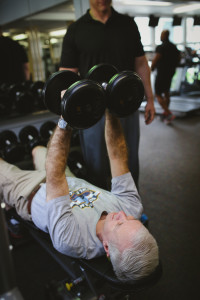Getting Seniors to Lift Weights Safely
Why Personal Training
When senior Shirley Webb found she couldn’t get off the floor without help, she knew it was time for a change. People often think that as they grow older they aren’t capable of exercising, or even worse, think they should stop. In fact, the World Health Organization says that seniors aged 65 and over should be doing moderate exercise for 150 minutes a week, or alternatively, intense exercise for 70 minutes a week. Stretched out over a period of time, this mean as little as 10 minutes a day.

Using The Method
With The Method, you’ll be able to get in a 60-minute personal training session. Our private training will benefit those like Shirley, and you too could soon be completing a 225-pound deadlift of your own. The Method will work as we provide you with a personal trainer at a private gym, allowing you to get the care and attention you need to practice good form when lifting weights. This is vital, as you could seriously injure yourself if you don’t have any guidance from professionals.
Find the Right Personal Trainer
Shirley actually credits her fitness trainer, John Wright, with her amazing turnaround. She says that Wright was able assure her that he’d be able to help when she thought there wasn’t anything she could do. Shirley goes on to say that her trainer watches her carefully, making sure her form is good to prevent any injuries occurring, and that she didn’t start off with heavy weights. She used lighter ones to raise her overall fitness level. This is the kind of training you’ll receive when practicing The Method at our private gyms with our personal trainers.
Pacing Yourself
When you’re working in the gym, you want to make sure the training you do is as effective as possible. Pacing yourself is the best way to ensure this, as you don’t want to strain yourself too quickly or pull a muscle. If you do, you’ll just set back your training, and you’ll have to begin again. Making sure you start with light weights is the best idea, allowing you to gradually work your way up to heavier ones as your overall fitness level increases. This slow, methodical, approach can lead to large improvements in performance over time, and greatly reduces the risk of injury from trying to train too hard.
Setting Goals
Setting goals is one of the best way to make sure you’re always pushing to become better. This doesn’t mean deciding that after your first week you should lift 300 pounds, but setting a more realistic goal. Shirley has said she’d like to work up to deadlifting 275 pounds, and that’s a realistic goal for her.
The American Council on Exercising suggests you should be specific with your goals. For example, when you look at your reasons for wanting to start training, “get healthy,” is far too general. Make sure you get down to the root of your reasons for wanting to train, whether it’s losing weight, stop smoking, lift a certain amount. Making your goals measurable is also a great idea. Add a number to it so you can track it. If last week you could lift 200 pounds, make the goal this week to lift 225. With an attainable goal like this, you’ll feel fantastic when you hit it.
